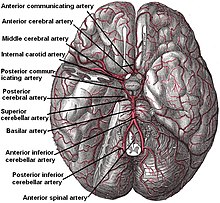| Cerebral hypoxia | |
|---|---|
| Other names | Anoxic brain injury, hypoxic brain injury, hypoxic ischemic encephalopathy |
 | |
| Arteries beneath brain, Circle of Willis | |
| Specialty | Critical care medicine |
| Symptoms | Poor judgement, memory loss, poor coordination, coma, seizure, brain death[1] |
| Causes | Cardiac arrest, drowning, strangulation, choking, suffocation, head trauma, carbon monoxide poisoning, severe anemia, drug overdose, low blood pressure, complications of general anesthesia[1][2] |
| Differential diagnosis | Epidural bleed, ischemic stroke, post ictal state, traumatic brain injury, subdural bleed[2] |
| Treatment | Depends on underlying cause, supportive care[1] |
| Prognosis | Often poor[2] |
| Frequency | >50% post cardiac arrest[2] |
Cerebral hypoxia is reduced oxygen supply to the brain; despite adequate blood flow.[1] In contrast "anoxia" is the complete lack of oxygen.[2] Symptoms may vary from poor judgement, memory loss, and poor coordination to coma, seizure, and brain death.[1]
Potential causes include cardiac arrest, drowning, strangulation, choking, suffocation, head trauma, carbon monoxide poisoning, severe anemia, drug overdose, low blood pressure, and complications of general anesthesia.[1][2] Injury to the brain, known as hypoxic brain injury or hypoxic ischemic encephalopathy (HIE), can occur within minutes and be permanent.[2][3]
Treatment depends on the underlying cause, but is generally supportive in nature.[1] This may include mechanical ventilation, intravenous fluids, medications to decrease seizures, and medications to support blood pressure.[1] Outcomes depend on the degree of brain damage and may not be clear for 72 hours.[1][2] Of those in a coma, about 30% regain consciousness, 10% remain in a coma, and 60% die.[2] Of those who regain consciousness, movement disorders and cognitive dysfunction are common.[2]
Hypoxic brain injury affects more than half of people who have a cardiac arrest.[2] When it occurs around the time of birth, known as birth asphyxia, it may result in neonatal hypoxic-ischemic encephalopathy.[4] This affects about 1.5 per 1,000 live births in the developing world.[5] In the developing world rates vary from 2 to 27 per 1,000 live births.[6]
References edit
- ^ a b c d e f g h i "Cerebral Hypoxia | National Institute of Neurological Disorders and Stroke". www.ninds.nih.gov. Archived from the original on 1 September 2022. Retrieved 26 September 2022.
- ^ a b c d e f g h i j k Lacerte, M; Hays Shapshak, A; Mesfin, FB (January 2022). "Hypoxic Brain Injury". PMID 30725995.
{{cite journal}}: Cite journal requires|journal=(help) - ^ "Hypoxic Ischemic Encephalopathy: Causes and Symptoms". Massachusetts General Hospital. Archived from the original on 27 September 2022. Retrieved 27 September 2022.
- ^ Gillam-Krakauer, M; Gowen Jr, CW (January 2022). "Birth Asphyxia". PMID 28613533.
{{cite journal}}: Cite journal requires|journal=(help) - ^ Kurinczuk, JJ; White-Koning, M; Badawi, N (June 2010). "Epidemiology of neonatal encephalopathy and hypoxic-ischaemic encephalopathy". Early human development. 86 (6): 329–38. doi:10.1016/j.earlhumdev.2010.05.010. PMID 20554402.
- ^ Lawn, JE; Lee, AC; Kinney, M; Sibley, L; Carlo, WA; Paul, VK; Pattinson, R; Darmstadt, GL (October 2009). "Two million intrapartum-related stillbirths and neonatal deaths: where, why, and what can be done?". International journal of gynaecology and obstetrics: the official organ of the International Federation of Gynaecology and Obstetrics. 107 Suppl 1: S5-18, S19. doi:10.1016/j.ijgo.2009.07.016. PMID 19815202.